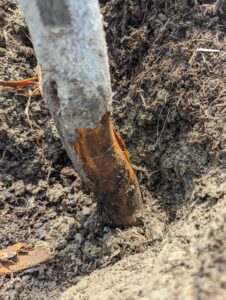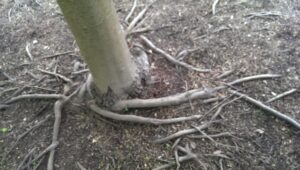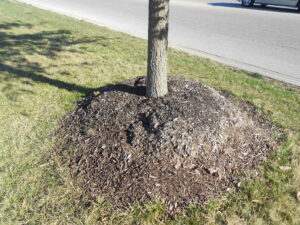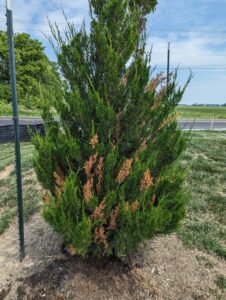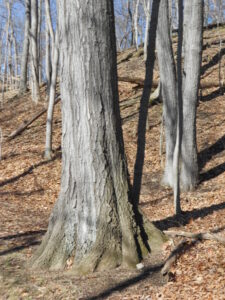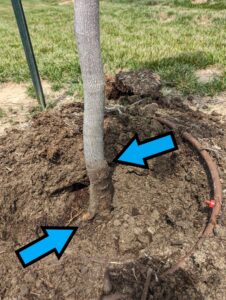Stop me if you’ve heard this one…. A tree is in a slow decline year after year. You are called to your client’s property only to find the root flare well below grade.
- Figure 1. A tree that’s planted too deep can have bark decay from too much soil moisture around the trunk.
Most professionals in the Green Industry have encountered this at some point in their career. The most common reason for the slow decline of trees in the landscape is due to the depth of planting and girdling roots. Deep planting can cause a number of deleterious problems, including an increase in circling/girdling roots restricting vascular tissue and decay of protective bark (Fig. 1). The vascular tissue in the bark is located on the outer portions of the trunk, while the anatomy of roots contains the vascular tissue in the center. This is why roots can graft with roots and stems can graft with stems, but also why roots can girdle the stems of trees (Fig. 2)
- Figure 2. Root girdling can occur on trees that didn’t have a root correction during transplanting and/or being planted too deep. Restriction of vascular tissue in the trunk will decrease the amount of water and nutrients taken up by the tree.
Excessive mounding of mulch (aka volcano mulch) (Fig. 3) can contribute to tree decline, very similar to a tree planted too deep. It’s important to remember that keeping mulch several inches away from the trunk is imperative in tree health.
- Figure 3. Volcano mulch can cause the same problems that a tree planted too deep can experience.
If a newly transplanted tree is planted significantly too deep, a faster decline can occur, especially in plants that can’t tolerate ‘wet feet’ (aka too much soil moisture) (Fig.4). In heavy-clay soils, the negative effects on tree health increase by creating a bath-tub situation by water not draining expeditiously after a rainfall or irrigation event.
- Figure 4. Decline of this juniper is caused by this tree being planted too deep.
- Figure 5. The root flare on trees in natural areas is very visible. This gives a lesson on proper planting into the landscape.
The root flare should be visible when transplanting trees into the landscape (Fig. 5). If no root flare is present, which is often on many conifers and smaller deciduous trees, the top most root should be considered at grade, or top of the root ball.
Always make sure to plant at grade, though there are a few minor exceptions, and never plant below grade (Fig. 6). Planting correctly is vitally important to the long-term viability of trees.
- Figure 6. This tree was planted significantly too deep and has led to decline and death.
